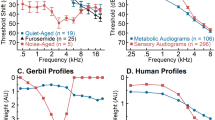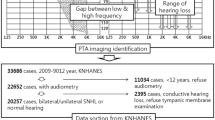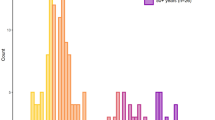Abstract
Presbyacusis, or age-related hearing loss, can be characterized in humans as metabolic and sensory phenotypes, based on patterns of audiometric thresholds that were established in animal models. The metabolic phenotype is thought to result from deterioration of the cochlear lateral wall and reduced endocochlear potential that decreases cochlear amplification and produces a mild, flat hearing loss at lower frequencies coupled with a gradually sloping hearing loss at higher frequencies. The sensory phenotype, resulting from environmental exposures such as excessive noise or ototoxic drugs, involves damage to sensory and non-sensory cells and loss of the cochlear amplifier, which produces a 50–70 dB threshold shift at higher frequencies. The mixed metabolic + sensory phenotype exhibits a mix of lower frequency, sloping hearing loss similar to the metabolic phenotype, and steep, higher frequency hearing loss similar to the sensory phenotype. The current study examined audiograms collected longitudinally from 343 adults 50–93 years old (n = 686 ears) to test the hypothesis that metabolic phenotypes increase with increasing age, in contrast with the sensory phenotype. A Quadratic Discriminant Analysis (QDA) was used to classify audiograms from each of these ears as (1) Older-Normal, (2) Metabolic, (3) Sensory, or (4) Metabolic + Sensory phenotypes. Although hearing loss increased systematically with increasing age, audiometric phenotypes remained stable for the majority of ears (61.5 %) over an average of 5.5 years. Most of the participants with stable phenotypes demonstrated matching phenotypes for the left and right ears. Audiograms were collected over an average period of 8.2 years for ears with changing audiometric phenotypes, and the majority of those ears transitioned to a Metabolic or Metabolic + Sensory phenotype. These results are consistent with the conclusion that the likelihood of metabolic presbyacusis increases with increasing age in middle to older adulthood.








Similar content being viewed by others
References
Allen PD, Eddins DA (2010) Presbycusis phenotypes form a heterogeneous continuum when ordered by degree and configuration of hearing loss. Hear Res 264:10–20
American National Standards Institute (2010) Specification for audiometers. ANSI S3.6–2010. American National Standards Institute, New York
American Speech-Language-Hearing Association (2005) Guidelines for manual pure-tone threshold audiometry. American Speech–Language–Hearing Association, Rockville, MD
Cruickshanks KJ, Tweed TS, Wiley TL et al (2003) The 5-year incidence and progression of hearing loss: the epidemiology of hearing loss study. Arch Otolaryngol Head Neck Surg 129:1041–1046
Demeester K, Van Wieringen A, Hendrick J et al (2009) Audiometric shape and presbycusis. Int J Audiol 48:222–232
Dubno JR, Dirks DD, Morgan DE (1984) Effects of age and mild hearing loss on speech recognition in noise. J Acoust Soc Am 76:87–96
Dubno JR, Eckert MA, Lee FS et al (2013) Classifying human audiometric phenotypes of age-related hearing loss from animal models. J Assoc Res Otolaryngol 14:687–701
Echt KV, Smith SL, Burridge AB, Spiro A (2010) Longitudinal changes in hearing sensitivity among men: the veterans affairs normative aging study. J Acoust Soc Am 128:1992–2002
Figueroa RL, Zeng-Treitler Q, Kandula S, Ngo LH (2012) Predicting sample size required for classification performance. BMC Med Inform Decis Mak 12:8
Gates GA, Schmid P, Kujawa SG et al (2000) Longitudinal threshold changes in older men with audiometric notches. Hear Res 141:220–228
Jerger J, Chmiel R, Stach B, Spretnjak M (1993) Gender affects audiometric shape in presbyacusis. J Am Acad Audiol 4:42–49
Kaya KH, Koç AK, Sayın İ et al (2015) Etiological classification of presbycusis in Turkish population according to audiogram configuration. The Turkish Journal of Ear Nose and Throat 25:1–8
Kujawa SG, Liberman MC (2006) Acceleration of age-related hearing loss by early noise exposure: evidence of a misspent youth. J Neurosci 26:2115–2123
Lee FS, Matthews LJ, Dubno JR, Mills JH (2005) Longitudinal study of pure-tone thresholds in older persons. Ear Hear 26:1–11
Matthews LJ, Lee FS, Mills JH, Dubno JR (1997) Extended high-frequency thresholds in older adults. J Speech Lang Hear Res 40:208–214
Mills JH, Schmiedt RA, Kulish LF (1990) Age-related changes in auditory potentials of Mongolian gerbil. Hear Res 46:201–210
Mills JH, Schmiedt RA, Schulte BA, Dubno JR (2006) Age-related hearing loss: a loss of voltage, not hair cells. Semin Hear 27:228–236
Schmiedt RA (2010) The physiology of cochlear presbycusis. In: Gordon-Salant S, Frisina RD, Popper AN, Fay R (eds) The aging auditory system. Springer, New York, pp. 9–38
Schmiedt RA (1996) Effects of aging on potassium homeostasis and the endocochlear potential in the gerbil cochlea. Hear Res 102:125–132
Schmiedt RA, Lang H, Okamura H-O, Schulte BA (2002) Effects of furosemide applied chronically to the round window: a model of metabolic presbyacusis. J Neurosci 22:9643–9650
Schuknecht HF, Gacek MR (1993) Cochlear pathology in presbyacusis. Ann Otol Rhinol Laryngol 102:1–16
Sha SH, Kanicki A, Dootz G et al (2008) Age-related auditory pathology in the CBA/J mouse. Hear Res 243:87–94
Tarnowski BI, Schmiedt RA, Hellstrom LI et al (1991) Age-related changes in cochleas of mongolian gerbils. Hear Res 54:123–134
Acknowledgments
This work was supported by the National Institutes of Health/National Institute on Deafness and Other Communication Disorders (P50 DC 000422) and the South Carolina Clinical and Translational Research (SCTR) Institute, NIH/NCRR grant number UL1 RR029882. This investigation was conducted in a facility constructed with support from Research Facilities Improvement Program, NIH/NCRR grant number C06 RR14516. We also thank the study participants.
Author information
Authors and Affiliations
Corresponding authors
Ethics declarations
Conflict of Interest
The authors state that they have no conflict of interest to declare.
Rights and permissions
About this article
Cite this article
Vaden, K.I., Matthews, L.J., Eckert, M.A. et al. Longitudinal Changes in Audiometric Phenotypes of Age-Related Hearing Loss. JARO 18, 371–385 (2017). https://doi.org/10.1007/s10162-016-0596-2
Received:
Accepted:
Published:
Issue Date:
DOI: https://doi.org/10.1007/s10162-016-0596-2




